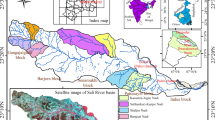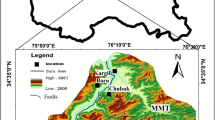Abstract
An integrated morphometric and hypsometric analysis coupled with asymmetric factor used as a proxy for the landscape evolution of the catchment of Karuvannur River. The present study area is a sixth order tropical river in the central Kerala which supplies water and sediments to the Vembanad-Kol Ramsar site. The Karuvannur River Basin (KRB) has been divided into six sub-watersheds (SW). Morphometric parameters (areal, linear, and relief) and hypsometric and asymmetric factors are measured for the delineation of morphotectonic evolution of the area. High values of drainage density, texture, ruggedness number, and hypsometric integral with relatively high volume of leftover rocks in the basin in SW-II and SW-III compared to the entire basin of KRB imply that these two sub-watersheds have been influenced by the tectonic activities. Further, detailed asymmetric data indicated that these two watersheds are tilted in opposite direction. It may be the result of reactivation of Precambrian fault/lineament in recent past. This has been supported by recent tremors and neotectonic studies in Kerala. Moreover, detailed field evidence along with google imagery revealed that the entire basin is a part of regional anticline associated with PCSZ. Geomorphic response to disturbance will produce a sensible, recognizable response; it can be well studied in rivers through detailed study of their sensitivity or behavioral changes. Rivers have an enormous capacity to absorb perturbation and these types of studies are essential for identifying/measuring tectonic activities, sediment diffusion, surface runoff in a drainage basin, and as an important tool for target oriented micro watershed management.





Similar content being viewed by others
Explore related subjects
Discover the latest articles and news from researchers in related subjects, suggested using machine learning.References
Abboud IA, Nofal A (2017) Morphometric analysis of Wadi Khumal Basin, western coast of Saudi Arabia, using remote sensing and GIS techniques. Journal of African Earth Sciences Vol 126:58–74. https://doi.org/10.1016/j.jafrearsci.2016.11.024
Ajayakumar P, Rajendran S, Mahadevan TM (2016) Geophysical lineaments of Western Ghats and adjoining coastal areas of central Kerala, southern India and their temporal development. Geoscience Frontiers xxx 2016:1–16. https://doi.org/10.1016/j.gsf.2016.11.005
Ambili V, Narayana AC (2014) Tectonic effects on the longitudinal profiles of the Chaliyar River and its tributaries southwest India. Geomorphology 217:37–47. https://doi.org/10.1016/j.geomorph.2014.04.013
Awasthi KD, Sitaula BK, Singh BR, Bajracharya RM (2002) Land-use change in two Nepalese watersheds: GIS and geomorphometric analysis. Land Degrad Dev 13:495–513
Burbank DW, Anderson RS (2001) Tectonic geomorphology. Blackwell Science Cambridge, p 274
Burrough PA, McDonnell RA (1998) Principles of geographical information systems. Oxford University Press, Oxford, p 306
Chen YC, Sung QC, Cheng KY (2003) Along-strike variations of morphotectonic features in the western foothills of Taiwan: tectonic implications based on stream gradient and hypsometric analysis. Geomorphology 56:109–137
Delcaillau B (2001) Geomorphic response to growing fault-related folds: example from escarpments in Attica, central Greece, and its relation to fault slip rates. Geomorphology 65:301–319
Eleni K, Skilodimou Hariklia D, Bathrellos George D, Assimina A, Evangelos K (2015) Morphotectonic analysis, structural evolution/pattern of a contractional ridge: Giouchtas Mt., Central Crete, Greece. J Earth Syst Sci 124(3):587–602. https://doi.org/10.1007/s12040-015-0551-3
Farhan Y (2017) Morphometric assessment of Wadi Wala Watershed Southern Jordan using ASTER (DEM) and GIS. J Geogr Inf Syst 9(02):p158
Ganas A, Pavlides S, Karastathis V (2005) DEM-based morphometry of range-front escarpments in Attica, central Greece, and its relation to fault slip rates. Geomorphology 65(3–4):301–319. https://doi.org/10.1016/j.geomorph.2004.09.006
Giorgis S (2015) Google earth mapping exercise for structural geology student-a promising intervention for improving penetrating visualizing ability. J Geosci Educ 63:140–146
Girish G, Ambili GK, Jesiya NP, Lemoon K (2016) Hydro-hypsometric analysis of tropical river basins, Southwest Coast of India using geospatial technology. J Mt Sci 13(5):936–946. https://doi.org/10.1007/s11629-0155-3589-4
Gopinath G, Ramisha N, Nair AG, Jesiya NP (2018) Spatial characters of a tropical river basin, south-west coast of India. In Hydrologic Modeling (pp. 641-657). Springer, Singapore
Gottschalk LC (1964) Reservoir sedimentation: VT Chow(ed) Hand book of applied hydrology. McGraw Hill Book Company, New York. Section pp7–1
Gravelius II (1914) Grundrifi der gesamten Gewcisserkunde. Band I: Flufikunde (Compendium of Hydrology, vol. I. Rivers, in German). Goschen, Berlin, Germany
GSI (1995) Geological and mineral map of Kerala. Geological Survey of India Govt, of India Ministry of Mines, Kolkata, India
Hadley RF, Schumm SA (1961) Sediment sources and drainage basin characteristics in upper Cheyenne River Basin. US Geol Survey Water-Supply Paper 1531-B:198
Horton RE (1932) Drainage-basin characteristics. Trans Am Geophys Union 13:350–361
Horton RE (1945) Erosional development of streams and their drainage basins: hydrophysical approach to quantitative morphology. Bull Geo Soc Am 56:275–370
Howard AD (1990) Role of hypsometry and planform in basin hydrologic response. Hydrol Process 4, pp373–385. https://www.ramsar.org/sites-countries/the-ramsar-sites, 373
Hurtrez JE, Sol C, Lucazeau F (1999) Effect of drainage area on hypsometry from an analysis of small-scale drainage basins in the Siwalik Hills (central Nepal). Earth Surf Process Landf 24:799–808
Jasmin I, Mallikarjuna P (2013) Morphometric analysis of Araniar river basin using remote sensing and geographical information system in the assessment of groundwater potential. Arab J Geosci 6(10):3683–3692. https://doi.org/10.1007/s12517-012-0627-1
Kamberis E, Bathrellos GD, Kokinou E, Skilodimou HD (2012) Correlation between the structural pattern and the development of the hydrographic network in a portion of the western Thessaly basin (Greece). Central Eur J Geosci 4(3):416–424. https://doi.org/10.2478/s13533-011-0074-7
Keller EA, Pinter N (2002) Active tectonics: earthquakes uplift and landscape-second edition. Prentice Hall, Upper Saddle River, NJ, p 362
Korup PG, Varadachar VVRG (1975) Hydrography of Purakkad mud bank region. Ind J Mar Sci 4:18–20
Langbein WB (1947) Topographic characteristics of drainage basins. U.S.G.S. Water Supply Paper 968C: pp127–157
Luo W (1997) Time to hydrograph peak and hypsometric curve. Geological Society of America Abstracts With Programs 29(7): pp A334
Luo W (2000) Quantifying groundwater-sapping landforms with a hypsometric technique. J Geophys Res, E, Planets 105(1):1685–1694
Luo W, Harlin JM (2003) A theoretical travel time based on watershed hypsometry. J Am Water Resour Assoc 39(4):785–792 https://doi.org/10.1111/j.1752-1688.2003.tb04405.x
Markose VJ, Jayappa KS (2011) Hypsometric analysis of Kali River Basin, Karnataka, India, using geographic information system. Geocarto Int 26(7):553–568. https://doi.org/10.1080/10106049.2011.608438
Müller RD, Yatheesh V, Shuhail M (2012) The tectonic stress field evolution of India since the Oligocene. Gondwana Res 28:612–624. https://doi.org/10.1016/j.gr.2014.05.008
Nag SK (1998) Morphometric analysis using remote sensing techniques in the Chaka sub basin Purulia district, West Bengal. J Indian Soc. Remote Sensing 26:69–76
Özkaymak C, Sözbilir H (2012) Tectonic geomorphology of the Spildağı high ranges western Anatolia. Geomorphology 173–174:128–140
Pike RJ, Wilson SE (1971) Elevation–relief ratio hypsometric integral and geomorphic area–altitude analysis. Geol Soc Am Bull 82:1079–1084
Praveen KR, Prasannakumar V, Mamtani MA (2009) Time relationship between regional deformation and fabric development in the Peralimala pluton, South India – inferences from magnetic fabric. J Geol Soc India 73:803–812
Radhakrishna T, Maluski H, Mitchell JG, Joseph M (1999) 40Ar/39Ar and K/Ar geochronology of the dykes from the south Indian granulite terrain. Tectonophysics 304:109–129
Rajendran CP, Biju J, Sreekumari K, Rajendran K (2009) Reassessing the earthquake hazard in Kerala based on the historical and current seismicity. J Geol Soc India 73:785–802
Rajendran CP, Rajendran K (1996) Low-moderate seismicity in the vicinity of Palghat Gap, South India and its implications. Curr Sci 70:305–308
Ramakrishnan M, Vaidyanadhan R (2008) Geology of India. Geological Society of India, Bangalore, pp 1–446
Ramkumar M, Menier D, Mathew M, Santosh M, Siddiqui Numair A (2017) Early Cenozoic rapid flight enigma of the Indian subcontinent resolved: roles of topographic top loading and subcrustal erosion. Geosci Front 8(1):15–23. https://doi.org/10.1016/j.gsf.2016.05.004
Rogers WJ (1971) Hydrograph analysis and some related variables in quantitative geomorphology-some aspects and application. M. Morisowa, (edn).Binghamto, New York, State Uni. of New York
Rudraih M, Govindaih S, Srinivas Vittala S (2008) Morphometry using remote sensing and GIS techniques in the sub-basins of Kagna river basin, Gulburga district, Karnataka. India J Indian Soc Remote Sens 36(4):351–360
Saikia U, Rai SS, Subrahmanyam M, Bose DS, Borah S, Kajaljyoti M, Rishikesh (2014) Accurate location and focal mechanism of small earthquakes near Idukki reservoir, Kerala: implication for earthquake genesis. Curr Sci 107(11):1885–1891
Santosh M, Yang QY, Shaji E, Tsunogae M, RamMohan M, Satyanarayanan M (2015) An exotic Mesoarchean microcontinent: the Coorg, Block, southern India. Gond Res 29:105–135
Schumm SA (1956) Evolution of drainage systems and slopes in badlands at Perth Amboy New Jersey. Geol Soc Am Bull 67:597–646
Smith KG (1950) Standards for grading texture of erosional topography. Am J Sci 248:655–668
Strahler AN (1952) Hypsometric (area-altitude) analysis of erosional topography. Bull Geol Soc Am 63:1117–1142
Strahler AN (1957) Quantitative analysis of watershed geomorphology. Trans Amer Geophys Union 38:913–920
Strahler AN (1964) Quantitative geomorphology of drainage basins and channel networks. In: Chow VT (ed) Handbook of applied hydrology. McGraw Hill, New York, pp 439–476
Tsodoulos IM, Koukouvelas IK, Pavlides S (2008) Tectonic geomorphology of the easternmost extension of the Gulf of Corinth Beotia, Central Greece. Tectonophysics 453:211–232
Valdiya KS, Narayana AC (2007) River response to neotectonic activity: example from Kerala, India. J Geol Soc Ind, V 70:427–443
Vijith H, Dodge-Wan D (2018) Morphology and channel characteristics of an equatorial tropical river in Malaysian Borneo: a detailed evaluation through spatially explicit geomorphometric modelling. Modeling Earth Systems and Environment 4(1):325–337
Vijith H, Prasannakumar V, Krishnan MVN, Pratheesh P (2015) Morphotectonics of a small river basin in the south Indian granulite terrain: an assessment through spatially derived geomorphic indices. Georisk 9(3):187–199. https://doi.org/10.1080/17499518.2015.1074251
Vijith H, Prasannakumar V, Sharath Mohan MA, Ninu Krishnan MV, Pratheesh P (2017) River and basin morphometric indexes to detect tectonic activity: a case study of selected river basins in the South Indian Granulite Terrain (SIGT). Phys Geogr 38(4):360–378. https://doi.org/10.1080/02723646.2017.1283478
Willgoose GR, Hancock G (1998) Revisiting the hypsometric curve as an indicator of form and process in transport-limited catchment. Earth Surf Process Landf 23:611–623
Wilson JP, Gallant JC (2000) Terrain analysis, principles and applications. Wiley, p 520
Yatheesh V, Dyment J, Bhattacharya GC, Muller RD (2013) Deciphering detailed plate kinematics of the Indian Ocean and developing a unified model for East Gondwana land reconstruction: an Indian Australian-French initiative. DCS-DST News Letter 23:1–63
Acknowledgements
The authors wish to acknowledge the Director General, Geological Survey of India (GSI), the Chairman, CGWB and the Executive Director, CWRDM (Centre for Water Resources Development and Management) Kozhikode, for their immense support. Further, we would like to extend our gratitude to the two unknown reviewers and editors for their constructive comments for improving the manuscript.
Author information
Authors and Affiliations
Corresponding author
Rights and permissions
About this article
Cite this article
Bhadran, A., Vijesh, V.K., Gopinath, G. et al. Morpho-hypsometric evolution of the Karuvannur River Basin, a tropical river in central Kerala, southwestern peninsular India. Arab J Geosci 11, 430 (2018). https://doi.org/10.1007/s12517-018-3794-x
Received:
Accepted:
Published:
DOI: https://doi.org/10.1007/s12517-018-3794-x
Keywords
Profiles
- Arun Bhadran View author profile
- Girish Gopinath View author profile




